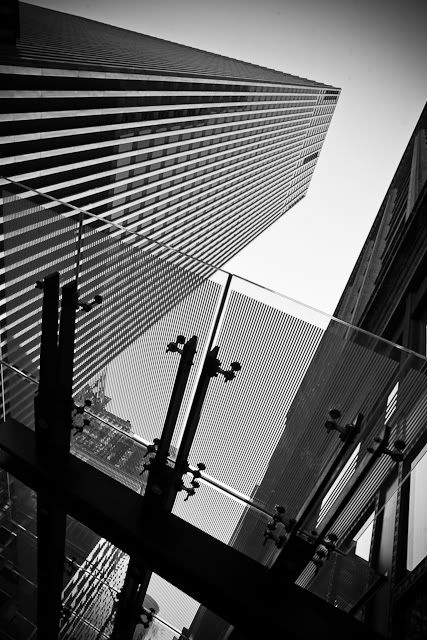In this picture the buildings and the sky interact to create an almost abstract image of geometric shapes. the key shape is that of the sky. A slow shutter speed was probably used alone with some serious dodging to achieve the tone and blur in the clouds. A wide angle lens was probably necessary to get a view that includes so much of the buildings on each side. Though it looks almost HDR, I would guess that it is just a lot of dodging and burning based on the light on the edges of the buildings.
Monday, December 13, 2010
Jason King
This is another photograph that shows that uses a dynamic negative shape to connect the architecture. Here smaller elements are used up-close to act as similar elements as the buildings. The light and the banner both feel as colossal as the buildings and function on the same plane as them. The curve of the light post and the arches on the building relate easily to the ripple of the banner. The corner of the building in the bottom left closes off the negative shape though it remains open on the other side. The sky is slightly gradated which contains the photograph space slightly but it still feels a little too open to me.
Eric Kim
After seeing Eric's photography, I have started being more aware of the space and negative shapes made by buildings in the city. This photograph is an especially strong example of how that negative shape can be used to activate the photograph. The titled camera allows the overhang to keep they diagonal zigzag going rather then grounding it as it would if that heavy black line were horizontal. The sky is handled by some subtle vignetting in the upper right hand corner. This gradation of the sky contains the photograph, allowing the eye to continue in a circular motion around the frame.
Monday, December 6, 2010
Matt Weber
Flat photography usually dont interest me but in street photography, I really like graphic element it adds. The shapes of the railing and the mosaic activate the space, balancing each other out. The girl adds the crucial element of interest being the subject. The scuffs on the wall appear to be confetti spewing from her outstretched arm; her upturned face drawing the attention into the picture. Her shape is perfectly balanced by the inclusion of the protruding piece of wall decoration in the opposite corner.
The dramatic light created by the fog here really makes this picture. The contrast between the soft and swirling fog and the hard edged city seem to pull the human shape between two worlds. The fact that the figure is fully covered by the fog allows it remain some what isolated from the city. The lines from where the street meets the buildings draws the eye into the center as do the verticals above it. The distance from which the picture was taken makes it feel more like an intrusion on a surreal almost ritualistic moment.
The real strength in this picture lies in the subject, 9/11. However it's unconventional view of the towers shows a side of it not seen from the plethora of after math pictures shown in most newspapers. The inclusion of the children who are completely oblivious to what is happening around them and the mother, forced to ignore it so she can continue taking care of her kids turns the focus towards the affect on the rest of America. The diagonals in the image draw the focus to the distant and muted towers while the contrasts make allow the figures to maintain the center of focus.
Subscribe to:
Posts (Atom)





